On this page, you’ll learn two versions of F major. First, the more common, more difficult version that you may have stumbled on already. Plus a much easier version that’s perfect for beginners.
You’ll learn tips for both that will have you playing the F chord in just a few minutes.
For many people, the F Major chord on guitar is the trickiest hurdles as they get started.
For some, it’s the chord that makes them put their guitar back in the closet. But it doesn’t have to be.
The reason why the F chord can be so challenging for people as they get started is that it is a barre in it. A barre happens when you use one finger to play more than one string. Like this:
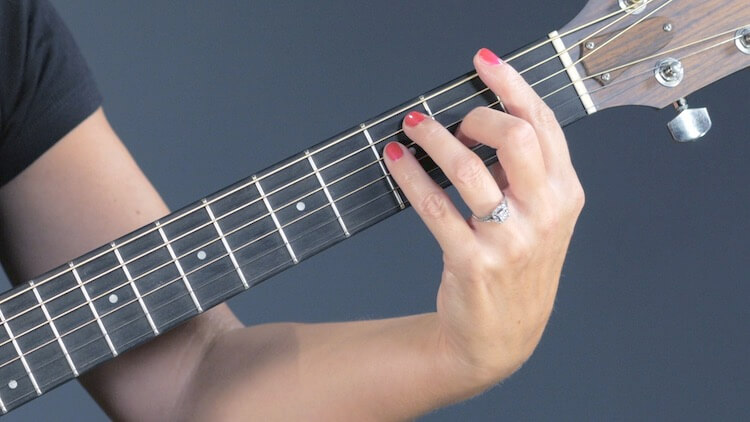
You can see that the first finger is stretched all the way across the strings, while the second, third, and fourth fingers are each only playing a single string.
This takes hand strength and coordination that takes time to build.
But don’t worry: this is a struggle that every guitar player has faced, and overcome.
Let’s first look at how to make this chord a little easier, and then try playing something that’s more in reach for people just beginning to play.
Here is a diagram for the fully-barred version of F major.

As you can see, the first finger is stretched all the way across, and it’s pressing down on the first, second, and sixth strings.
Let’s look at a close up of how that looks:

A few things from Anna’s form you should take notice of:
Notice how Anna’s first finger, the one performing the barre, is somewhat curved.
Even though it’s stretched across all six strings, if you look closely at the diagram, you’ll notice that it only has to push down on the first, second, and sixth strings–the thinnest two strings, and the thickest one.
Don’t waste your effort trying to push down the middle three.
Particularly with those third and fourth fingers, it can be tricky to keep them from touching the string next to the one they’re supposed to be pushing down.
The trick?
Keep your fingers curved so that the very tip of the finger is pushing down on the string, not the pad of the finger where your fingerprint is.
Look how open Anna’s hand is. It’s because she’s holding an egg.
Not really.
But pretend she had an egg in the palm of her hand. Her thumb is on the back of the guitar’s neck, leaving and empty spot in the palm of her hand so big, she could hold an egg there if she wanted to.
This gives her lots of leverage to clamp down on those strings.
Look how close Anna’s fingers are, particularly her first finger, to the fret in front of the one she’s targeting.
That makes it much easier to push the string down cleanly against the fret.
If you’re not getting a nice, clean sound, try moving your fingers closer to the body of your guitar.
If you’re having a hard time playing the fully barred F chord, try this easier version.
It sounds great, and there’s no reason you can’t continue to play this version as long as you want, maybe forever.
It looks something like this:
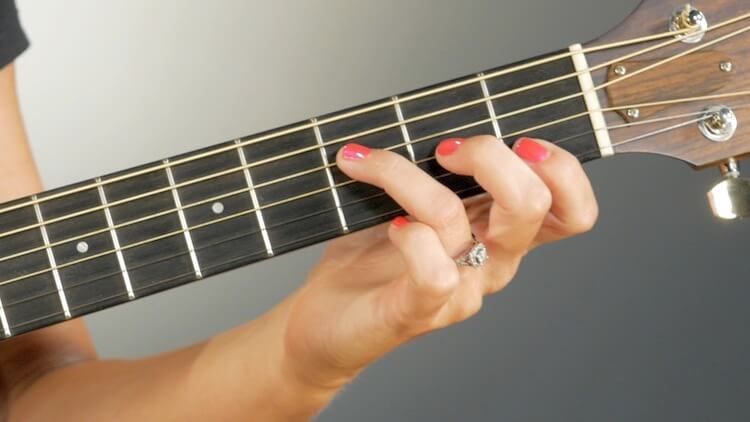
You can see that, instead of the first string stretched all the way across six strings, it’s just covering the thinnest two.
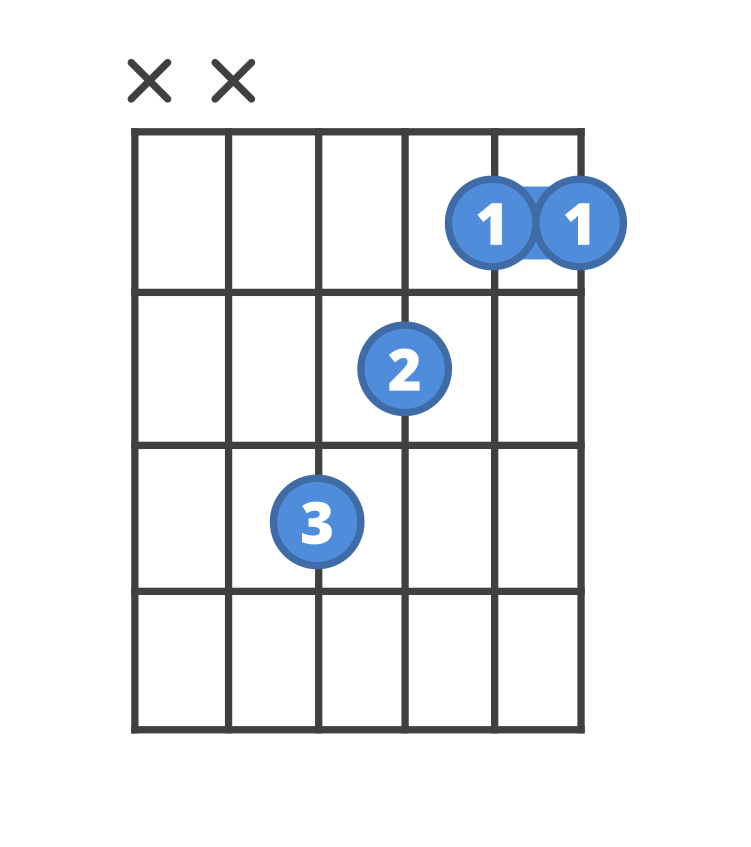
First, take your first finger, and lay it across the thinnest two strings, just behind your guitar’s first fret:

Next, take your second finger, and place it one string towards the ceiling, one fret towards the body of the guitar.
And, lastly, take your third finger, and go one string up, one string over, one last time.

Then, just play the thinnest four strings. See how Anna rests her pick on the fourth string before she strums? This is a great way to make sure you’re starting with good habits.
This part is important! This smaller barre only works because you’re not playing those thickest two strings.
A few tips to make things easier:
This version of the F chord is easier than the fully barred version, but you still need to arch those second and third fingers.
Remember: you want just the tip of those second and third fingers to touch the strings. Not the pad of your finger. Leave no fingerprints!
If your strings are buzzing, try moving your fingers up closer to the next fret.
You’ll need less pressure to push down on the strings.
Don’t forget–for this version, just strum the thinnest four strings.

Do barre chords scare you? They don’t have to.
We have an excellent video series by Anna Freitas that will demystify Barre Chords once and for all.
You’ll learn to play the most important barre chord shapes, with tips for finding your way up and down the fretboard, changing chords, and getting rid of that awful fret buzz that plagues beginning players.
Here are some direct links to ChordBank’s practice drills and games for beginners learning the F# chord.
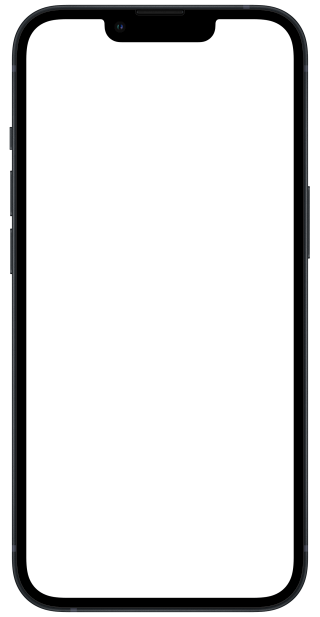
These Smart Flashcards will listen as you play, flipping automatically as they hear you strum chords on your guitar.
To start working through the easier to play version of F major, try playing it alongside Am and C.

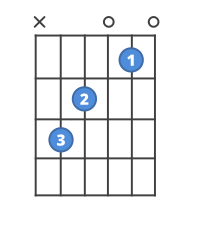
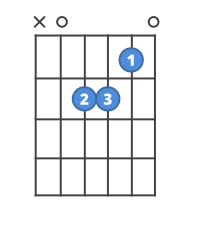
Keep your first finger planted on that second string at the first fret, and focus on moving your second and third fingers.
This will help you internalize the F shape, and get you comfortable changing between other chords.
Perhaps the most commonly used three chords in all of pop music, you should not only know C, F, and G major, you should be able to switch between them naturally.



Adding the G chord to the mix will force you to move your whole hand to a new shape, and then find the F chord again as the card comes back up.
This is a new level of mastery–take your time with it, and remember to take breaks if you start getting tired.
Practicing a little bit every day is better than practicing a lot once a week.
The D minor chord and A minor chord are great complements to the F chord.



This deck of flashcards will help you hear how they sound against your F major chord, and help you continue your journey towards changing cleanly between chords.
If it feels hard: good! Anything worth doing is hard. Keep at it, a little each day.
You can use ChordBank to practice chords, while playing silly games that use the sounds your guitar makes instead of a joystick.


Try playing ChordPOP! or Blast-o-chords while taking your fingers on and off the strings. ChordBank will listen to your iPhone’s microphone, and fire darts, blow up falling rocks as you play.